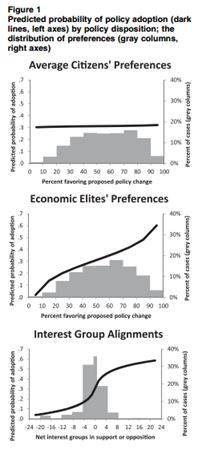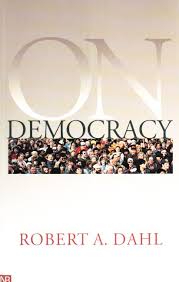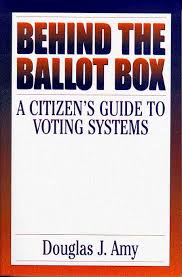For a more thorough approach to the issue of political power in America, consider the original Princeton study which Represent.Us references in their video, which is presented here, edited for length.
Testing Theories of American Politics: Elites, Interest Groups, and Average Citizens
By Martin Gilens and Benjamin I. Page (Source, edited for length) | Who governs? Who really rules? To what extent is the broad body of U.S. citizens sovereign, semisovereign, or largely powerless? These questions have animated much important work in the study of American politics. While this body of research is rich and variegated, it can loosely be divided into four families of theories: Majoritarian Electoral Democracy, Economic-Elite Domination, and two types of interest-group pluralism—Majoritarian Pluralism, in which the interests of all citizens are more or less equally represented, and Biased Pluralism, in which corporations, business associations, and professional groups predominate.
Each of these perspectives makes different predictions about the independent influence upon U.S. policy making of four sets of actors: the Average Citizen or“median voter,” Economic Elites, and Mass-based or Business-oriented Interest Groups or industries. Each of these theoretical traditions has given rise to a large body of literature. Each is supported by a great deal of empirical evidence—some of it quantitative, some historical, some observational—concerning the importance of various sets of actors (or, all too often, a single set of actors) in U.S. policy making. This literature has made important contributions to our understanding of how American politics works and has helped illuminate how democratic or undemocratic (in various senses) our policy making process actually is. Until very recently, however, it has been impossible to test the differing predictions of these theories against each other within a single statistical model that permits one to analyze the independent effects of each set of actors upon policy outcomes.
Here—in a tentative and preliminary way—we offer such a test, bringing a unique data set to bear on the problem. Our measures are far from perfect, but we hope that this first step will help inspire further research into what we see as some of the most fundamental questions about American politics.
The central point that emerges from our research is that economic elites and organized groups representing business interests have substantial independent impacts on U.S. government policy, while mass-based interest groups and average citizens have little or no independent influence. Our results provide substantial support for theories of Economic-Elite Domination and for theories of Biased Pluralism, but not for theories of Majoritarian Electoral Democracy or Majoritarian Pluralism.
In what follows, we briefly review the four theoretical traditions that form the framework for our analyses and highlight some of the most prominent empirical research associated with each. We then describe our data and measures and present our results. We conclude by discussing the implications of our work for understanding American democracy and by identifying some of the directions for future research that our findings suggest.
Four Theoretical Traditions
Majoritarian Electoral Democracy
Theories of majoritarian electoral democracy, as positive or empirical theories, attribute U.S. government policies chiefly to the collective will of average citizens, who are seen as empowered by democratic elections. Such thinking goes back at least to Tocqueville, who (during the Jacksonian era) saw American majorities as “omnipotent”—particularly at the state level—and worried about “tyranny of the majority.” It is encapsulated in Abraham Lincoln’s reference to government “of the people, by the people, for the people,” and was labeled by Robert Dahl “populistic democracy.”
Economic-Elite Domination
A quite different theoretical tradition argues that U.S. policy making is dominated by individuals who have substantial economic resources, i.e., high levels of income or wealth—including, but not limited to, ownership of business firms.
Not all “elite theories”share this focus. Some emphasize social status or institutional position—such as the occupancy of key managerial roles in corporations, or top-level positions in political parties, in the executive, legislative, or judicial branches of government, or in the highest ranks of the military. Some elite theories postulate an amalgam of elites, defined by combinations of social status, economic resources, and institutional positions, who achieve a degree of unity through common backgrounds, coinciding interests, and social interactions.
Majoritarian Pluralism
The roots of what we can characterize as theories of “majoritarian” interest-group pluralism go back to James Madison’s Federalist Paper No. 10, which analyzed politics in terms of “factions”—a somewhat fuzzy concept that apparently encompassed political parties and even popular majorities, as well as what we would today consider organized interest groups, business firms, and industrial sectors. Madison argued that struggles among the diverse factions that would be found in an extensive republic would lead to policies more or less representative of the needs and interests of the citizenry as a whole—or at least would tend to defeat “tyrannical” policies, including the much-feared issuance of inflationary paper money that might cater to local majority factions of farmer-debtors but would be costly to merchant creditors.
Biased Pluralism
Olson’s argument [referenced within the full study] points toward an important variant line of thinking within the pluralist tradition: theories of “biased ” pluralism, which posit struggles among an unrepresentative universe of interest groups—characterized by E.E. Schattschneider as a heavenly chorus with an “upper-class accent,” and more recently dubbed by Kay Lehman Schlozman, Sidney Verba, and Henry Brady an “unheavenly chorus.” Theories of biased pluralism generally argue that both the thrust of interest-group conflict and the public policies that result tend to tilt toward the wishes of corporations and business and professional associations.
American Democracy?
Each of our four theoretical traditions (Majoritarian Electoral Democracy, Economic-Elite Domination, Majoritarian Interest-Group Pluralism, and Biased Pluralism) emphasizes different sets of actors as critical in determining U.S. policy outcomes, and each tradition has engendered a large empirical literature that seems to show a particular set of actors to be highly influential. Yet nearly all the empirical evidence has been essentially bivariate. Until very recently it has not been possible to test these theories against each other in a systematic, quantitative fashion.
By directly pitting the predictions of ideal-type theories against each other within a single statistical model (using a unique data set that includes imperfect but useful measures of the key independent variables for nearly two thousand policy issues), we have been able to produce some striking findings. One is the nearly total failure of “median voter” and other Majoritarian Electoral Democracy theories. When the preferences of economic elites and the stands of organized interest groups are controlled for, the preferences of the average American appear to have only a minuscule, near-zero, statistically non-significant impact upon public policy.
The failure of theories of Majoritarian Electoral Democracy is all the more striking because it goes against the likely effects of the limitations of our data. The preferences of ordinary citizens were measured more directly than our other independent variables, yet they are estimated to have the least effect.
Nor do organized interest groups substitute for direct citizen influence, by embodying citizens’ will and ensuring that their wishes prevail in the fashion postulated by theories of Majoritarian Pluralism. Interest groups do have substantial independent impacts on policy, and a few groups (particularly labor unions) represent average citizens’ views reasonably well. But the interest-group system as a whole does not. Overall, net interest-group alignments are not significantly related to the preferences of average citizens. The net alignments of the most influential, business-oriented groups are negatively related to the average citizen’s wishes. So existing interest groups do not serve effectively as transmission belts for the wishes of the populace as a whole. “Potential groups” do not take up the slack, either, since average citizens’ preferences have little or no independent impact on policy after existing groups’ stands are controlled for.
Furthermore, the preferences of economic elites (as measured by our proxy, the preferences of “affluent” citizens) have far more independent impact upon policy change than the preferences of average citizens do. To be sure, this does not mean that ordinary citizens always lose out; they fairly often get the policies they favor, but only because those policies happen also to be preferred by the economically-elite citizens who wield the actual influence.
Of course our findings speak most directly to the “first face” of power: the ability of actors to shape policy outcomes on contested issues. But they also reflect—to some degree, at least—the “second face” of power: the ability to shape the agenda of issues that policy makers consider. The set of policy alternatives that we analyze is considerably broader than the set discussed seriously by policy makers or brought to a vote in Congress, and our alternatives are (on average) more popular among the general public than among interest groups. Thus the fate of these policies can reflect policy makers’ refusing to consider them rather than considering but rejecting them. (From our data we cannot distinguish between the two.) Our results speak less clearly to the “third face” of power: the ability of elites to shape the public’s preferences. We know that interest groups and policy makers themselves often devote considerable effort to shaping opinion. If they are successful, this might help explain the high correlation we find between elite and mass preferences. But it cannot have greatly inflated our estimate of average citizens’ influence on policy making, which is near zero.
What do our findings say about democracy in America? They certainly constitute troubling news for advocates of “populistic” democracy, who want governments to respond primarily or exclusively to the policy preferences of their citizens. In the United States, our findings indicate, the majority does not rule—at least not in the causal sense of actually determining policy outcomes. When a majority of citizens disagrees with economic elites or with organized interests, they generally lose. Moreover, because of the strong status quo bias built into the U.S. political system, even when fairly large majorities of Americans favor policy change, they generally do not get it.
A possible objection to populistic democracy is that average citizens are inattentive to politics and ignorant about public policy; why should we worry if their poorly informed preferences do not influence policy making? Perhaps economic elites and interest-group leaders enjoy greater policy expertise than the average citizen does. Perhaps they know better which policies will benefit everyone, and perhaps they seek the common good, rather than selfish ends, when deciding which policies to support.
But we tend to doubt it. We believe instead that— collectively—ordinary citizens generally know their own values and interests pretty well, and that their expressed policy preferences are worthy of respect. Moreover, we are not so sure about the informational advantages of elites. Yes, detailed policy knowledge tends to rise with income and status. Surely wealthy Americans and corporate executives tend to know a lot about tax and regulatory policies that directly affect them. But how much do they know about the human impact of Social Security, Medicare, food stamps, or unemployment insurance, none of which is likely to be crucial to their own well-being? Most important, we see no reason to think that informational expertise is always accompanied by an inclination to transcend one’s own interests or a determination to work for the common good.
All in all, we believe that the public is likely to be a more certain guardian of its own interests than any feasible alternative.
Leaving aside the difficult issue of divergent interests and motives, we would urge that the superior wisdom of economic elites or organized interest groups should not simply be assumed. It should be put to empirical test. New empirical research will be needed to pin down precisely who knows how much, and what, about which public policies.
Our findings also point toward the need to learn more about exactly which economic elites (the “merely affluent”? the top 1 percent? the top one-tenth of 1 percent?) have how much impact upon public policy, and to what ends they wield their influence. Similar questions arise about the precise extent of influence of particular sets of organized interest groups. And we need to know more about the policy preferences and the political influence of various actors not considered here, including political party activists, government officials, and other noneconomic elites. We hope that our work will encourage further exploration of these issues.
Despite the seemingly strong empirical support in previous studies for theories of majoritarian democracy, our analyses suggest that majorities of the American public actually have little influence over the policies our government adopts. Americans do enjoy many features central to democratic governance, such as regular elections, freedom of speech and association, and a widespread (if still contested) franchise. But we believe that if policymaking is dominated by powerful business organizations and a small number of affluent Americans, then America’s claims to being a democratic society are seriously threatened.













